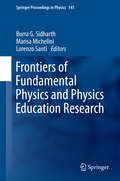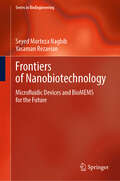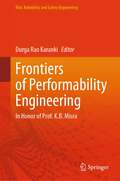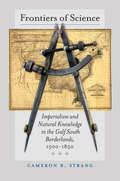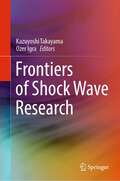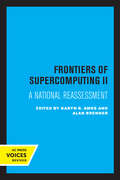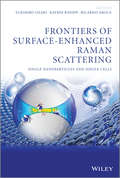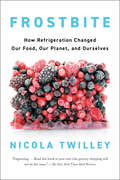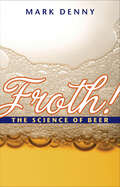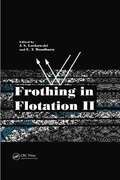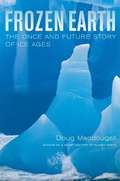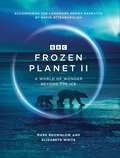- Table View
- List View
Frontiers of Fundamental Physics and Physics Education Research
by Burra G. Sidharth Marisa Michelini Lorenzo SantiIn a knowledge-based society, research into fundamental physics plays a vital role not only in the enhancement of human knowledge but also in the development of new technology that affects everyday life. The international symposium series Frontiers of Fundamental Physics (FFP) regularly brings together eminent scholars and researchers working in various areas in physics to exchange expertise, ideas, results, and new research perspectives. The twelfth such symposium, FFP12, took place at the University of Udine, Italy, and covered diverse fields of research: astrophysics, high energy physics and particle physics, theoretical physics, gravitation and cosmology, condensed matter physics, statistical physics, computational physics, and mathematical physics. Importantly, it also devoted a great deal of attention to physics education research, teacher training in modern physics, and popularization of physics. The high scientific level of FFP12 was guaranteed by the careful selection made by scientific coordinators from among 250 submissions from 28 countries across the world. During the three days of the conference, nine general talks were delivered in plenary sessions, 29 invited talks were given in specific topic areas, and 59 oral presentations were made. This book presents a selection of the best contributions at FFP12 with the aim of acquainting readers with the most important recent advances in fundamental physics and in physics education and teacher development.
Frontiers of Green Catalytic Selective Oxidations (Green Chemistry and Sustainable Technology)
by Konstantin P. BryliakovThe demand for novel efficient and environmentally sustainable chemo, regio- and stereoselective catalyst systems for the oxidation of organic substrates is continuously growing in line with toughening economic and environmental constraints. This book addresses these issues; it consists of eleven chapters written by world-recognized experts in green and sustainable oxidation catalysis. The most urgent and challenging topics, in the judgment of the editor, such as green asymmetric epoxidations, sulfoxidatiuons, C–H oxidations; oxidation catalysis by polyoxometalates and oxidations in non-conventional solvents, etc. have been critically reviewed in this book. Both fundamental aspects, such as catalysts design, catalytic properties, nature of catalytically active sites and reaction mechanisms, and practical outlook of the oxidations have been addressed by the authors. The book appeals to a broad readership, particularly graduate students, employees of universities and research organizations, and industrial researchers, particularly those working in the areas of homogeneous oxidation catalysis, asymmetric synthesis, organocatalysis, sustainable catalytic processes and green chemistry, mechanisms of catalytic reactions, synthesis of bioactive compounds, biomimetic chemistry, etc.Konstantin Bryliakov is Leading Researcher at the Boreskov Institute of Catalysis. In 2016, he was elected Honorary Professor of the Russian Academy of Sciences.
Frontiers of Land and Water Governance in Urban Areas (Routledge Special Issues on Water Policy and Governance)
by Thomas Hartmann and Tejo SpitA society that intensifies and expands the use of land and water in urban areas needs to search for solutions to manage the frontiers between these two essential elements for urban living. Sustainable governance of land and water is one of the major challenges of our times. Managing retention areas for floods and droughts, designing resilient urban waterfronts, implementing floating homes, or managing wastewater in shrinking cities are just a few examples where spatial planning steps into the governance arena of water management and vice versa. However, water management and spatial planning pursue different modes of governance, and therefore the frontiers between the two disciplines require developing approaches for setting up governance schemes for sustainable cities of the future. What are the particularities of the governance of land and water? What is the role of regional and local spatial planning? What institutional barriers may arise? This book focuses on questions such as these, and covers groundwater governance, water supply and wastewater treatment, urban riverscapes, urban flooding, flood risk management, and concepts of resilience. The project resulted from a Summer School by the German Academy for Spatial Research and Planning (ARL) organized by the editors at Utrecht University in 2013.This book was published as a special issue of Water International.
Frontiers of Nanobiotechnology: Microfluidic Devices and BioMEMS for the Future (Series in BioEngineering)
by Seyed Morteza Naghib Yasaman RezaeianThis book provides a comprehensive overview of microfluidic-assisted devices and bioMEMS, covering their fundamental principles, manufacturing processes, and biomedical applications. It explores the design, fabrication, and integration of microfluidic devices and MEMS, emphasizing their role in microscale physics and biomedical engineering. Key topics include micropumps, biosensors, and organ-on-a-chip systems, with applications in drug discovery, disease diagnosis, and tissue engineering. The book also discusses recent advances in the field, particularly the integration of biosensors with microfluidic systems, highlighting their growing impact on biomedical research and healthcare innovations.
Frontiers of Performability Engineering: In Honor of Prof. K.B. Misra (Risk, Reliability and Safety Engineering)
by Durga Rao KarankiThis book presents recent advances in performability analysis methods and their applications in different fields. It covers various aspects of performability such as quality, reliability, maintainability, availability, safety, security, and sustainability that are essential in complex engineering systems such as electrical grids, chemical plants, naval defense systems, structures, nuclear reactors, railways, etc. This book is a collection of research works contributed by the former students of Professor KB Mishra who is a renowned researcher in reliability engineering. This book is useful for the researchers and professionals working in the area of performability engineering.
Frontiers of Quantum Chemistry
by Yukihiro Ozaki Bernard Kirtman Marek J. Wójcik Hiroshi NakatsujiThe purpose of this book is to convey to the worldwide scientific community the rapid and enthusiastic progress of state-of-the-art quantum chemistry. Quantum chemistry continues to grow with remarkable success particularly due to rapid progress in supercomputers. The usefulness of quantum chemistry is almost limitless. Its application covers not only physical chemistry but also organic and inorganic chemistry, physics, and life sciences. This book deals with all of these topics. Frontiers of Quantum Chemistry is closely related to the symposium of the same name held at Kwansei Gakuin University at Nishinomiya, Japan, in November 2015. The book's contributors, however, include not only invited speakers at the symposium but also many other distinguished scientists from wide areas of quantum chemistry around the world.
Frontiers of Science: Imperialism and Natural Knowledge in the Gulf South Borderlands, 1500-1850 (Published by the Omohundro Institute of Early American History and Culture and the University of North Carolina Press)
by Cameron B. StrangCameron Strang takes American scientific thought and discoveries away from the learned societies, museums, and teaching halls of the Northeast and puts the production of knowledge about the natural world in the context of competing empires and an expanding republic in the Gulf South. People often dismissed by starched northeasterners as nonintellectuals--Indian sages, African slaves, Spanish officials, Irishmen on the make, clearers of land and drivers of men--were also scientific observers, gatherers, organizers, and reporters. Skulls and stems, birds and bugs, rocks and maps, tall tales and fertile hypotheses came from them. They collected, described, and sent the objects that scientists gazed on and interpreted in polite Philadelphia. They made knowledge.Frontiers of Science offers a new framework for approaching American intellectual history, one that transcends political and cultural boundaries and reveals persistence across the colonial and national eras. The pursuit of knowledge in the United States did not cohere around democratic politics or the influence of liberty. It was, as in other empires, divided by multiple loyalties and identities, organized through contested hierarchies of ethnicity and place, and reliant on violence. By discovering the lost intellectual history of one region, Strang shows us how to recover a continent for science.
Frontiers of Shock Wave Research
by Ozer Igra Kazuyoshi TakayamaThe book contains 12 chapters written by well-known shock wave researchers from seven different countries. Each researcher provides a brief description of his main research interests and results, thereby providing the readers with an excellent view of shock wave research conducted in the past fifty years. It also provides hints as to what still needs further investigation. It will be an excellent guide for young researchers entering the field of shock wave phenomena. Among the described investigations are the following topics: Blast wave interaction with a body when the body is in the area of interference of two blast waves moving in different directions; equation of state for water based on the shock Hugoniot data; Mach waves occurring over a backward facing edge in supersonic flow; shock waves in dusty gas; shock wave interaction with various bodies; three shock interactions.
Frontiers of Space Risk: Natural Cosmic Hazards & Societal Challenges
by Richard J. Wilman and Christopher J. NewmanCHOICE Recommended Title, March 2019 This book brings together diverse new perspectives on current and emerging themes in space risk, covering both the threats to Earth-based activities arising from space events (natural and man-made), and those inherent in space activity itself. Drawing on the latest research, the opening chapters explore the dangers from asteroids and comets; the impact of space weather on critical technological infrastructure on the ground and in space; and the more uncertain threats posed by rare hazards further afield in the Milky Way. Contributors from a wide range of disciplines explore the nature of these risks and the appropriate engineering, financial, legal, and policy solutions to mitigate them. The coverage also includes an overview of the space insurance market; engineering and policy perspectives on space debris and the sustainability of the space environment. The discussion then examines the emerging threats from terrorist activity in space, a recognition that space is a domain of war, and the challenges to international cooperation in space governance from the nascent asteroid mining industry. Features: Discusses developments and risks relevant to the public and private sectors as access to the space environment expands Offers an interdisciplinary approach blending science, technology, and policy Presents a high-level international focus, with contributions from academics, policy makers, and commercial space consultants
Frontiers of Supercomputing II: A National Reassessment (Los Alamos Series in Basic and Applied Sciences #13)
by Karyn R. Ames Alan BrennerThis uniquely comprehensive book brings together the vast amount of technical, economic, and political information and the analyses of supercomputing that have hitherto been buried in the frequently inaccessible "gray literature." Seventy-nine distinguished participants in the second Frontiers of Supercomputing conference offer perceptive and often controversial views on the emerging computing environment in the United States. This title is part of UC Press's Voices Revived program, which commemorates University of California Press’s mission to seek out and cultivate the brightest minds and give them voice, reach, and impact. Drawing on a backlist dating to 1893, Voices Revived makes high-quality, peer-reviewed scholarship accessible once again using print-on-demand technology. This title was originally published in 1994.
Frontiers of Surface-Enhanced Raman Scattering
by Yukihiro Ozaki Katrin Kneipp Ricardo ArocaA comprehensive presentation of Surface-Enhanced Raman Scattering (SERS) theory, substrate fabrication, applications of SERS to biosystems, chemical analysis, sensing and fundamental innovation through experimentation. Written by internationally recognized editors and contributors. Relevant to all those within the scientific community dealing with Raman Spectroscopy, i. e. physicists, chemists, biologists, material scientists, physicians and biomedical scientists. SERS applications are widely expanding and the technology is now used in the field of nanotechnologies, applications to biosystems, nonosensors, nanoimaging and nanoscience.
Frontiers: Twentieth Century Physics
by Steve AdamsThe revolution in twentieth-century physics has offered answers to many of the big questions of existence, such as the ultimate nature of things and how the universe came into being. It has undermined our belief in a Newtonian mechanistic universe and a deterministic future, posing questions about parallel universes, time-travel, and the origin and end of everything. At the same time we have witnessed amazing attempts at unification so that physicists are able to contemplate the discovery of a single theory of everything from which we could derive the masses and types of all particles and their interactions. This book tells the story of these discoveries and the people who made them, largely through the work of Nobel Prize-winning physicists.
Fronts, Waves and Vortices in Geophysical Flows
by Jan-Bert FlorMost well known structures in planetary atmospheres and the Earth's oceans are jets or fronts interacting with vortices on a wide range of scales. The transition from one state to another, such as in unbalanced or adjustment flows, involves the generation of waves as well as the interaction of coherent structures with these waves. This book presents a fluid mechanics perspective to the dynamics of fronts and vortices and their interaction with waves in geophysical flows. It provides a basic physical background for modeling coherent structures in a geophysical context, and it gives essential information on advanced topics such as spontaneous wave emission and wavemomentum transfer in geophysical flows. Based on a set of lectures by leading specialists, this text is targeted at graduate students, researchers and engineers in geophysics and environmental fluid mechanics.
Frost (Scholastic Press Novels)
by M. P. KozlowskyCinder meets The Walking Dead in a chilling futuristic fairy tale that will reboot everything you thought about family, love… and what it means to be human.Before he died, Frost's father uploaded his consciousness into their robot servant. But the technology malfunctioned, and now her father fades in and out. So when Frost learns that there might be medicine on the other side of the ravaged city, she embarks on a dangerous journey to save the only living creature she loves.With only a robot as a companion, Frost must face terrors of all sorts, from outrunning the vicious Eaters. . .to talking to the first boy she's ever set eyes on. But can a girl who's only seen the world through books and dusty windows survive on her own?
Frostbite: How Refrigeration Changed Our Food, Our Planet, and Ourselves
by Nicola TwilleyWinner of the James Beard Award for Literary Writing "Engrossing...hard to put down." — The New York Times Book Review&“Frostbite is a perfectly executed cold fusion of science, history, and literary verve . . . as a fellow nonfiction writer, I bow down. This is how it's done.&” — Mary Roach, author of Fuzz and StiffAn engaging and far-reaching exploration of refrigeration, tracing its evolution from scientific mystery to globe-spanning infrastructure, and an essential investigation into how it has remade our entire relationship with food—for better and for worseHow often do we open the fridge or peer into the freezer with the expectation that we&’ll find something fresh and ready to eat? It&’s an everyday act—but just a century ago, eating food that had been refrigerated was cause for both fear and excitement. The introduction of artificial refrigeration overturned millennia of dietary history, launching a new chapter in human nutrition. We could now overcome not just rot, but seasonality and geography. Tomatoes in January? Avocados in Shanghai? All possible.In Frostbite, New Yorker contributor and cohost of the award-winning podcast Gastropod Nicola Twilley takes readers on a tour of the cold chain from farm to fridge, visiting off-the-beaten-path landmarks such as Missouri&’s subterranean cheese caves, the banana-ripening rooms of New York City, and the vast refrigerated tanks that store the nation&’s orange juice reserves. Today, nearly three-quarters of everything on the average American plate is processed, shipped, stored, and sold under refrigeration. It&’s impossible to make sense of our food system without understanding the all-but-invisible network of thermal control that underpins it. Twilley&’s eye-opening book is the first to reveal the transformative impact refrigeration has had on our health and our guts; our farms, tables, kitchens, and cities; global economics and politics; and even our environment.In the developed world, we&’ve reaped the benefits of refrigeration for more than a century, but the costs are catching up with us. We&’ve eroded our connection to our food and redefined what &“fresh&” means. More important, refrigeration is one of the leading contributors to climate change. As the developing world races to build a US-style cold chain, Twilley asks: Can we reduce our dependence on refrigeration? Should we? A deeply researched and reported, original, and entertaining dive into the most important invention in the history of food and drink, Frostbite makes the case for a recalibration of our relationship with the fridge—and how our future might depend on it.
Froth!: The Science of Beer
by Mark DennyBest Beer Book in the United States of America, 2009 Gourmand World Cookbooks AwardsEver wonder where the bubbles in your beer came from, which way they are going, and why? Have you considered the physical differences among ales, lambics, and lagers? Do you contemplate your pint? Accomplished homebrewer and physicist Mark Denny has crafted a scientifically sound and witty investigation of the physics and chemistry of beer. He recounts and explains the history of and key technological advances in brewing, provides basic instructions for making your own—including a scientific-yet-accessible account of the changes in appearance during each stage of the process—and looks at the fascinating physical phenomena contained within a pint of beer. Along the way he defines the main concepts and terms involved in the process and shows how you can subject the technical aspects of brewing to scientific analysis. If you've ever been curious about how beer is made, why it froths so well, and what makes different types... well... different, then Froth! is for you.
Froth!: The Science of Beer
by Mark Denny“A theoretical physicist’s exploration of the math and science behind the beer-brewing process. Packed with humor, history, and DIY enthusiasm.” —Seed MagazineBest Beer Book in the United States of America, 2009 Gourmand World Cookbook AwardsEver wonder where the bubbles in your beer came from, which way they are going, and why? Have you considered the physical differences among ales, lambics, and lagers? Do you contemplate your pint?Accomplished homebrewer and physicist Mark Denny has crafted a scientifically sound and witty investigation of the physics and chemistry of beer. He recounts and explains the history of and key technological advances in brewing, provides basic instructions for making your own—including a scientific-yet-accessible account of the changes in appearance during each stage of the process—and looks at the fascinating physical phenomena contained within a pint of beer. Along the way he defines the main concepts and terms involved in the process and shows how you can subject the technical aspects of brewing to scientific analysis.If you’ve ever been curious about how beer is made, why it froths so well, and what makes different types . . . well . . . different, then Froth! is for you.“Froth! earns a solid ‘A’ for bringing science, brewing, and good writing together.” —Beerfestivals.org“Books about beer tend to be either purely descriptive or wholly scientific. Rarely does a book combine the two, much less with genuine wit and charm. Froth! . . . is the exception. It is a great joy to read and contains a wealth of information for a wide audience . . . Highly recommended.” —Choice
Frothing in Flotation II: Recent Advances in Coal Processing, Volume 2 (Recent Advances In Coal Processing Ser. #Vol. 2.)
by J. S. Laskowski E. T. WoodburnDr. J. S. Laskowski has written several papers on frother-collector interactions and the effect of such interactions on flotation kinetics, and on frothers chemistry and frothing. He is founder and Editor-in-Chief of the journal, Coal Preparation. Dr. E. T. Woodburn has published numerous papers on flotation froth and flotation kinetics. Frothing in Flotation, published in honor of Jan Leja, appeared in 1989. Many important contributions on various aspects of flotation froth properties and behavior and the relationship between froth appearance and flotation performance have appeared since, and this volume intends to summarize these achievements. Flotation kinetics involves a number of mass transfer processes with some of them being critically determined by the behavior of froth. Since froth is complex, and controlled experimentation is difficult, the froth phase was, until recently, either ignored or treated entirely empirically. With wide applications of flotation columns, the behavior of the froth is now often recognized as being dominant in determining flotation performance, and the research in this area is one of the most actively pursued.
Frozen Earth: The Once and Future Story of Ice Ages
by Douglas MacdougallDoug Macdougall explores the causes and effects of ice ages that have gripped our planet throughout its history, from the earliest known glaciations -- nearly three billion years ago -- to the present.
Frozen Earth: The Once and Future Story of Ice Ages
by Douglas MacdougallAn accessible account of the nature and global effects of Ice Ages, including the history of how several maverick scientists developed various pieces of our current scientific theory of these times, and how recent studies of Pleistocene climate may help us understand Earth's future climate changes.
Frozen Fauna of the Mammoth Steppe: The Story of Blue Babe
by R. Dale GuthrieFrozen mammals of the Ice Age, preserved for millennia in the tundra, have been a source of fascination and mystery since their first discovery over two centuries ago. These mummies, their ecology, and their preservation are the subject of this compelling book by paleontologist Dale Guthrie. The 1979 find of a frozen, extinct steppe bison in an Alaskan gold mine allowed him to undertake the first scientific excavation of an Ice Age mummy in North America and to test theories about these enigmatic frozen fauna. The 36,000-year-old bison mummy, coated with blue mineral crystals, was dubbed "Blue Babe. " Guthrie conveys the excitement of its excavation and shows how he made use of evidence from living animals, other Pleistocene mummies, Paleolithic art, and geological data. With photographs and scores of detailed drawings, he takes the reader through the excavation and subsequent detective work, analyzing the animal's carcass and its surroundings, the circumstances of its death, its appearance in life, the landscape it inhabited, and the processes of preservation by freezing. His examination shows that Blue Babe died in early winter, falling prey to lions that inhabited the Arctic during the Pleistocene era. Guthrie uses information gleaned from his study of Blue Babe to provide a broad picture of bison evolutionary history and ecology, including speculations on the interactions of bison and Ice Age peoples. His description of the Mammoth Steppe as a cold, dry, grassy plain is based on an entirely new way of reading the fossil record.
Frozen Fauna of the Mammoth Steppe: The Story of Blue Babe
by R. Dale GuthrieFrozen mammals of the Ice Age, preserved for millennia in the tundra, have been a source of fascination and mystery since their first discovery over two centuries ago. These mummies, their ecology, and their preservation are the subject of this compelling book by paleontologist Dale Guthrie. The 1979 find of a frozen, extinct steppe bison in an Alaskan gold mine allowed him to undertake the first scientific excavation of an Ice Age mummy in North America and to test theories about these enigmatic frozen fauna. The 36,000-year-old bison mummy, coated with blue mineral crystals, was dubbed "Blue Babe." Guthrie conveys the excitement of its excavation and shows how he made use of evidence from living animals, other Pleistocene mummies, Paleolithic art, and geological data. With photographs and scores of detailed drawings, he takes the reader through the excavation and subsequent detective work, analyzing the animal's carcass and its surroundings, the circumstances of its death, its appearance in life, the landscape it inhabited, and the processes of preservation by freezing. His examination shows that Blue Babe died in early winter, falling prey to lions that inhabited the Arctic during the Pleistocene era. Guthrie uses information gleaned from his study of Blue Babe to provide a broad picture of bison evolutionary history and ecology, including speculations on the interactions of bison and Ice Age peoples. His description of the Mammoth Steppe as a cold, dry, grassy plain is based on an entirely new way of reading the fossil record.
Frozen Planet II
by Elizabeth White Mark BrownlowACCOMPANIES THE LANDMARK SERIES NARRATED BY DAVID ATTENBOROUGHFind a world of wonder beyond the ice. 'Looking down at our planet from space it may come as a surprise how much of it is blanketed in snow and ice. These vast frozen wildernesses cover more than a fifth of the earth ... From the highest peaks to snow-bound deserts to alien worlds deep beneath the ice, they are home to an astonishing array of animals found nowhere else on earth.'David Attenborough, from the series.Frozen Planet II celebrates the surprisingly diverse worlds of ice - a world that is disappearing before our very eyes. Previously undiscovered stories, from chameleons giving birth on the frosty slopes of Mount Kenya to endangered Amur leopards in the Russian forest and killer whales hunting Weddell seals on ice floes in the Antarctic, shed new light on the beauty and the peril of the world's most fragile ecosystems. Behind-the-scenes insights explore the unique challenges of filming in these frozen worlds, where camera crew and wildlife alike brave the extreme conditions.With over 250 stunning full-colour photographs, Frozen Planet II reveals the wonders of the fastest-changing part of our planet, as we may never see them again.
Frozen in Time
by John Geiger Owen BeattieThe Franklin expedition was not alone in suffering early and unexplained deaths. Indeed, both Back (1837) and Ross (1849) suffered early onset of unaccountable "debility" aboard ship and Ross suffered greater fatalities during his single winter in the Arctic than did Franklin during his first. Both expeditions were forced to retreat because of the rapacious illness that stalked their ships. Frozen in Time makes the case that this illness (starting with the Back expedition) was due to the crews' overwhelming reliance on a new technology, namely tinned foods. This not only exposed the seamen to lead, an insidious poison - as has been demonstrated in Franklin's case by Dr. Beattie's research - but it also left them vulnerable to scurvy, the ancient scourge of seafarers which had been thought to have been largely cured in the early years of the nineteenth century. Fully revised, Frozen in Time will update the research outlined in the original edition, and will introduce independent confirmation of Dr. Beattie's lead hypothesis, along with corroboration of his discovery of physical evidence for both scurvy and cannibalism. In addition, the book includes a new introduction written by Margaret Atwood, who has long been fascinated by the role of the Franklin Expedition in Canada's literary conscience, and has made a pilgrimage to the site of the Franklin Expedition graves on Beechey Island.
Frozen in Time
by Margaret Atwood John Geiger Owen BeattieThe truth about what happened on Sir John Franklin's ill-fated Arctic expedition of 1845-48 has been shrouded in mystery for 165 years. Carrying the best equipment that the science and technology, Franklin and his men set out to "penetrate the icy fastness of the north, and to circumnavigate America." The expedition's two ships - HMS Erebus and HMS Terror - carrying 129 officers and men, disappeared without a trace. From 1846 to 1880 more than 20 major rescue parties were involved in the search for the missing men and ships. The disappearance of the expedition and absence of any substantial written accounts of the journey have left attempts at a reconstruction of events sketchy and inconclusive. In Frozen in Time, forensic anthropologist Owen Beattie and historian John Geiger tell the dramatic story of the excavation of three sailors from the Franklin Expeditions, buried for 138 years on the lonely headland of Beechey Island. This book contains the astonishing photographic record of the excavation, together with the maps and illustrations that accompany this riveting account of Franklin's fatal adventure. The unfolding of Dr. Beattie's unexpected findings is not only a significant document but also, in itself, a tale of high adventure.
